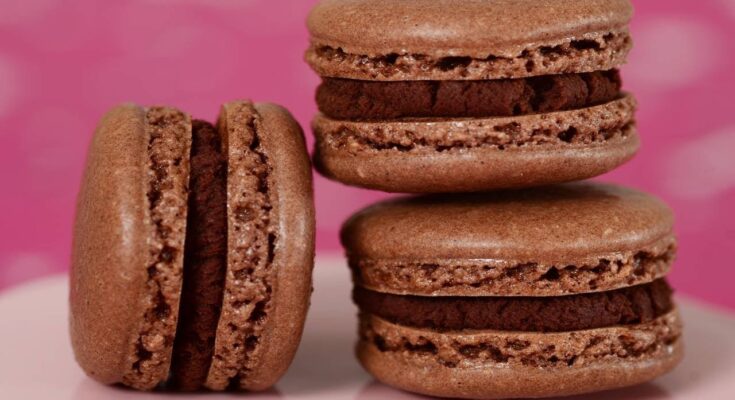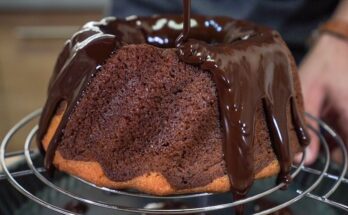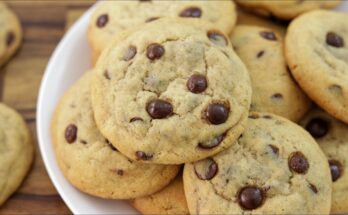Chocolate Macaron Recipe: Chocolate macarons are one of the most loved French desserts. With their smooth, crisp shells and rich chocolate ganache filling, these delicate treats are often seen as a symbol of elegance in the world of baking. Many beginners find macarons intimidating because they require precision, patience, and technique. However, once you understand the process, making chocolate macarons at home can be incredibly rewarding.
So, what exactly makes macarons so special? Unlike cookies or cakes, macarons combine texture and flavor in a unique way. The outer shell is slightly crunchy, while the inside is soft and chewy, creating a delightful contrast in every bite. And when paired with a creamy chocolate ganache, the flavor balance is truly irresistible.
Before we dive into the step-by-step recipe, let’s clarify a common confusion: the difference between macarons and macaroons. While they sound similar, they are two completely different desserts. Macarons are delicate French sandwich cookies made with almond flour and meringue, while macaroons are chewy coconut-based treats. Knowing this difference is important so you don’t mix them up when baking.
In this guide, we’ll walk through all the details you need—from ingredients to common mistakes—to help you create bakery-quality chocolate macarons at home.
Ingredients You’ll Need
Before starting, it’s essential to gather all the right ingredients. Unlike some desserts where substitutions are flexible, macarons need precise ingredients and measurements for success.
Core Ingredients for Chocolate Macarons:
- Almond flour (100g) – finely ground, blanched almonds are key to achieving smooth shells.
- Powdered sugar (200g) – helps keep the macaron shells light and delicate.
- Cocoa powder (25g) – use unsweetened cocoa powder for a rich chocolate flavor.
- Egg whites (100g, about 3 large eggs) – aged egg whites whip up better for meringue.
- Granulated sugar (100g) – stabilizes the meringue.
- Salt (a pinch) – balances sweetness.
For the Chocolate Ganache Filling:
- Dark chocolate (150g, chopped) – high-quality chocolate ensures a smooth, rich filling.
- Heavy cream (150ml) – creates a creamy texture.
- Unsalted butter (20g, optional) – adds extra richness and shine.
Optional Flavor Variations:
- Add vanilla extract for extra depth.
- Try espresso powder to enhance chocolate flavor.
- Swap dark chocolate with milk or white chocolate for variation.
Tools and Equipment Required:
- Mixing bowls
- Electric hand mixer or stand mixer
- Sifter
- Piping bags with round tips
- Baking trays lined with parchment paper or silicone mats
- Spatula
- Kitchen scale (highly recommended)
With all your ingredients and tools ready, you’re set to start baking. Remember, preparation is half the battle in macaron-making.
Preparing the Ingredients Properly
Many bakers underestimate the importance of preparation, but for macarons, it’s crucial. Properly prepared ingredients ensure smooth batter, perfect shells, and stable meringue.
Sifting Almond Flour and Cocoa Powder
Almond flour and cocoa powder tend to clump. If you skip sifting, your macaron shells may end up grainy. Sift both ingredients together with powdered sugar at least twice for a fine, lump-free mixture. This ensures your macarons will have smooth tops.
How to Age Egg Whites for Macarons
Aging egg whites may sound unnecessary, but it plays a key role. Leave egg whites in a clean bowl, covered loosely with plastic wrap, in the fridge for 24–48 hours. This reduces moisture, helping them whip up into a more stable meringue. When ready to use, bring them to room temperature for best results.
Tips for Measuring Ingredients Accurately
Macarons require precision, so always measure with a kitchen scale instead of cups. Even small deviations can affect the batter. For example, too much almond flour can make the shells dense, while too much egg white can cause spreading.
Once your ingredients are sifted, aged, and measured, you’re ready to move on to the actual baking process.
Step-by-Step Guide to Making Chocolate Macarons
This is where the magic happens. Follow these steps carefully, and you’ll be on your way to baking chocolate macarons like a pro.
Step 1 – Preparing the Dry Ingredients
In a bowl, combine sifted almond flour, powdered sugar, and cocoa powder. Mix gently until everything is evenly distributed. This will be folded into the meringue later.
Step 2 – Whipping the Egg Whites into Meringue
Place room-temperature egg whites in a clean, dry bowl. Begin whisking at medium speed until foamy. Add a pinch of salt and gradually add granulated sugar, one tablespoon at a time. Continue whisking until stiff peaks form. The meringue should look glossy and hold its shape when you lift the whisk.
Step 3 – Folding the Macaron Batter (Macaronage Technique)
Add the dry mixture into the meringue in batches. Gently fold with a spatula, pressing the batter against the sides of the bowl to release air. The consistency should be like lava—thick but able to flow slowly. When you lift the spatula, the batter should fall in ribbons and settle smoothly within 10–15 seconds.
Step 4 – Piping the Macarons Perfectly
Transfer the batter into a piping bag fitted with a round tip. Pipe small, even circles (about 1.5 inches) onto a lined baking tray. Tap the tray firmly on the counter to release air bubbles. Use a toothpick to pop any remaining bubbles for smooth tops.
Step 5 – Resting the Shells Before Baking
Let the piped shells rest at room temperature for 30–60 minutes until they form a skin. When you touch the surface lightly, the batter shouldn’t stick to your finger. This step is crucial for creating the signature macaron “feet.”
Step 6 – Baking to Perfection
Preheat your oven to 300°F (150°C). Place the trays in the middle rack to ensure even heat distribution. Bake for 15–18 minutes, rotating the tray halfway through. The macarons are done when the shells don’t wobble when touched lightly. Be careful not to overbake, as this can make them too dry and brittle.
A good test is to gently lift one macaron from the tray—if it comes off cleanly without sticking, it’s ready. Allow the macarons to cool completely on the tray before removing them. Cooling is vital because warm shells can break easily.
Step 7 – Preparing the Chocolate Ganache Filling
While the shells are cooling, prepare the ganache. Heat the heavy cream in a saucepan until it just begins to simmer. Pour the hot cream over the chopped dark chocolate in a bowl. Let it sit for 2–3 minutes before stirring. Mix gently until the chocolate is fully melted and smooth. If desired, add a small cube of butter for extra shine and creaminess.
Let the ganache cool until it thickens slightly but is still pipeable. This usually takes about 30 minutes at room temperature. If you’re in a hurry, place it in the fridge for 10 minutes, but stir occasionally to avoid hardening.
Step 8 – Assembling the Macarons
Match macaron shells of similar size. Pipe a dollop of chocolate ganache onto one shell and gently press another shell on top to form a sandwich. Don’t press too hard—just enough for the ganache to spread evenly.
For the best flavor, refrigerate the assembled macarons for 24 hours before serving. This resting period, known as “maturing,” allows the shells to absorb some of the ganache’s moisture, creating that classic chewy texture. Before serving, bring them back to room temperature for the ultimate taste.
Common Mistakes and How to Fix Them
Even experienced bakers face challenges when making macarons. Here are some common problems and solutions:
Why Macaron Shells Crack
- Cause: Not resting the shells long enough before baking.
- Solution: Ensure they form a skin before going into the oven. Increase resting time if your kitchen is humid.
How to Avoid Hollow Shells
- Cause: Overwhipping or underwhipping the meringue, or incorrect oven temperature.
- Solution: Whip egg whites until just stiff peaks, not dry. Bake at the right temperature, adjusting slightly if needed.
Getting the Perfect Feet
- Cause: Incorrect macaronage (batter folding) or low oven heat.
- Solution: Fold the batter until it flows like lava, and ensure your oven is fully preheated before baking.
Remember, macarons take practice. Don’t get discouraged if your first batch isn’t perfect—the beauty of baking is learning and improving with each attempt.
Storing and Serving Chocolate Macarons
After all the effort you’ve put in, proper storage ensures your macarons stay fresh and delicious.
How Long Do Macarons Last?
Macarons taste best when matured for 24 hours and consumed within 3–4 days. After that, the shells may lose their texture.
Freezing and Thawing Macarons
Macarons freeze beautifully. Place them in an airtight container, separating layers with parchment paper. They can be frozen for up to 2 months. When ready to enjoy, thaw them in the refrigerator overnight, then bring them to room temperature before serving.
Best Ways to Serve Macarons
Chocolate macarons pair wonderfully with coffee, tea, or even a glass of champagne for special occasions. Arrange them on a tiered dessert stand for parties, or package them in small boxes for thoughtful homemade gifts.
Tips for Perfecting Your Macaron Skills
Mastering macarons takes patience, but these tips can help you improve quickly:
Adjusting for Humidity and Climate
Macarons are sensitive to humidity. If you live in a humid area, use a dehumidifier in your kitchen or bake on a dry day. Resting times may also take longer in humid conditions.
Practicing the Macaronage Technique
The folding process (macaronage) is the heart of macaron making. Practice is the only way to perfect it. Remember: too much folding = runny batter, too little folding = stiff batter. Aim for that ribbon-like flow.
Experimenting with Fillings and Flavors
Once you master chocolate macarons, try other variations. Raspberry jam, salted caramel, pistachio cream, or even flavored buttercreams can transform your macarons into gourmet delights.
FAQs about Chocolate Macaron Recipe
1. Can I make macarons without almond flour?
Traditional macarons require almond flour, but you can substitute sunflower seed flour for a nut-free version.
2. Why are my macarons chewy?
Macarons are supposed to be slightly chewy, but if they’re too dense, it could be due to overmixing or underbaking.
3. Can I use regular cocoa powder for chocolate macarons?
Yes, use unsweetened cocoa powder. Avoid sweetened cocoa as it alters the balance of the recipe.
4. How long should macarons rest before baking?
30–60 minutes, or until a dry skin forms on top. This prevents cracks and helps develop feet.
5. What’s the best filling for chocolate macarons?
Chocolate ganache is the classic choice, but you can also try Nutella, espresso cream, or salted caramel.
Conclusion
Making chocolate macarons may seem intimidating at first, but with patience, preparation, and practice, anyone can master this elegant French treat. From sifting almond flour to perfecting the macaronage technique and filling them with silky ganache, every step brings you closer to enjoying bakery-quality macarons at home.
The best part? Once you’ve conquered chocolate macarons, an entire world of flavors and colors awaits. So grab your piping bag, trust the process, and indulge in the sweet reward of homemade macarons.



